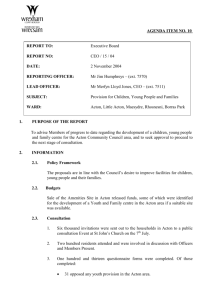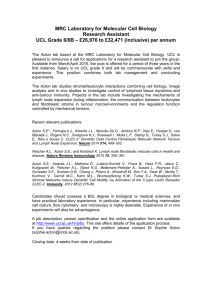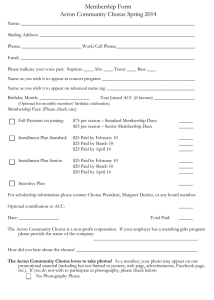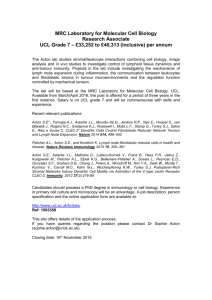Prue Acton Case Study (1964 - 1972)
advertisement
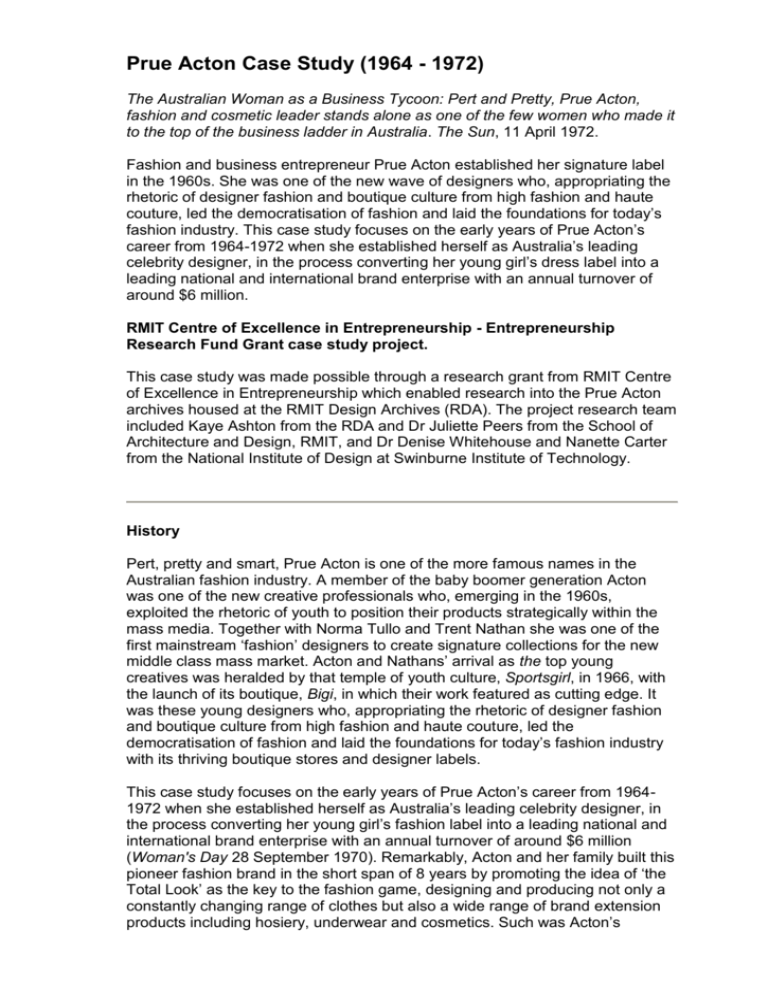
Prue Acton Case Study (1964 - 1972)
The Australian Woman as a Business Tycoon: Pert and Pretty, Prue Acton,
fashion and cosmetic leader stands alone as one of the few women who made it
to the top of the business ladder in Australia. The Sun, 11 April 1972.
Fashion and business entrepreneur Prue Acton established her signature label
in the 1960s. She was one of the new wave of designers who, appropriating the
rhetoric of designer fashion and boutique culture from high fashion and haute
couture, led the democratisation of fashion and laid the foundations for today’s
fashion industry. This case study focuses on the early years of Prue Acton’s
career from 1964-1972 when she established herself as Australia’s leading
celebrity designer, in the process converting her young girl’s dress label into a
leading national and international brand enterprise with an annual turnover of
around $6 million.
RMIT Centre of Excellence in Entrepreneurship - Entrepreneurship
Research Fund Grant case study project.
This case study was made possible through a research grant from RMIT Centre
of Excellence in Entrepreneurship which enabled research into the Prue Acton
archives housed at the RMIT Design Archives (RDA). The project research team
included Kaye Ashton from the RDA and Dr Juliette Peers from the School of
Architecture and Design, RMIT, and Dr Denise Whitehouse and Nanette Carter
from the National Institute of Design at Swinburne Institute of Technology.
History
Pert, pretty and smart, Prue Acton is one of the more famous names in the
Australian fashion industry. A member of the baby boomer generation Acton
was one of the new creative professionals who, emerging in the 1960s,
exploited the rhetoric of youth to position their products strategically within the
mass media. Together with Norma Tullo and Trent Nathan she was one of the
first mainstream ‘fashion’ designers to create signature collections for the new
middle class mass market. Acton and Nathans’ arrival as the top young
creatives was heralded by that temple of youth culture, Sportsgirl, in 1966, with
the launch of its boutique, Bigi, in which their work featured as cutting edge. It
was these young designers who, appropriating the rhetoric of designer fashion
and boutique culture from high fashion and haute couture, led the
democratisation of fashion and laid the foundations for today’s fashion industry
with its thriving boutique stores and designer labels.
This case study focuses on the early years of Prue Acton’s career from 19641972 when she established herself as Australia’s leading celebrity designer, in
the process converting her young girl’s fashion label into a leading national and
international brand enterprise with an annual turnover of around $6 million
(Woman's Day 28 September 1970). Remarkably, Acton and her family built this
pioneer fashion brand in the short span of 8 years by promoting the idea of ‘the
Total Look’ as the key to the fashion game, designing and producing not only a
constantly changing range of clothes but also a wide range of brand extension
products including hosiery, underwear and cosmetics. Such was Acton’s
success as a design entrepreneur that by 1972 she was attracting accolades
which included Fashion Pictorial’s 'Personality of the Month’ (1966), the
International Sales Promotion Executives Association’s ‘Man of the Year’ (1970)
and the Australian Wool Board’s ‘Lyrebird’ fashion award (1971).
Acton was often called Australia’s Mary Quant. And like Quant, the English
designer credited with popularising the 'mod' look in the 1950s, she was media
savvy, launching herself as a celebrity brand in what has to be one of the
cleverest public relations exercises in Australian fashion history. From day one,
in 1964, when as a 19 year old she launched her business with the help of her
mother Gwen, Acton attracted extensive editorial coverage in the daily press,
with her 'infectious smile' and 'giggle and curly blond hair' becoming the
trademarks of a promotional rhetoric that positioned her as a leader of youth
fashion (2 FOOTNOTE). The media relished and repeated the story of girl fresh
out of art school (RMIT Textiles) who establishes a business in the centre of the
old rag trade district, Flinders Lane, designing and manufacturing clothes that
she and her girl friends want to wear.
Knowing that ‘young ladies’ of the day did not want to emulate their mothers'
lack of fashion style, Acton promoted the idea that her designs were for ‘young
thinking people’ who wanted fun clothes to express their personalities and
identity (1966, 'Personality of the month: Prue Acton and the modified mods',
Fashion Pictorial). Her little A-line ‘shift’ dresses, hipster skirts, culottes and
coats featuring short hemlines, peter pan collars, pretty prints, bold colours, and
connotations of cute, modern school/business girl sexuality, were a response to
young women’s greater freedom of choice in virtually all aspects of their lives
including education, employment, travel, sex and marriage. With her mother as
public relations agent, Acton played out these youth identity politics in the press,
beginning from the early days when she was strategically photographed as the
young creative teenager with note pad and pencil sketching ideas, engrossed
working on the floor of her fashion studio.
Playing out the milestones of her life and career in the media spotlight, Acton
made fashion and design part of everyday culture, part of what it meant to be
baby boomer. As the media reported, this meant juggling her marriage to fellow
designer Mike Treloar, motherhood and home making, and being the liberated
business woman who regularly travelled abroad developing outlets and
establishing licensees in New York, Singapore, Japan, London and New
Zealand. Greeted by the press on her return from overseas, her predictions
about the next fashion trend were quickly reported, drawing attention to the
importance of youth fashion to the national economy. Amazingly, she was given
front page status as a commentator on issues ranging from the plight of the
fashion industry to women’s liberation and national identity. Always wearing
meticulously coordinated and constantly changing looks, with matching
everything - outfit, hairstyle, makeup, shoes, stockings, colours, fabric - she
became the personification of both the 1960s ideal Total Look and the young,
educated woman’s entry into the business sector.
Part of Acton's success was timing, emerging as she did in the 1964-1966
period when British pop culture, Beatlesmania, Twiggy, Carnaby Street and
boutique culture were at their peak. Australia’s interest in the ‘teenager' market
began to surface in the early 1960s amid concern about the decline in clothing
purchases as consumers were increasingly spending their disposable income
on cars, homes and holidays. The one sector experiencing success was the
Young Look fashion market with its specialty stores and boutiques. Statistically
the 15-24 year age group was an expanding market, with the potential to grow
from 12.9 % of the retail market to 15.5 % by the 1970s, with its female sector
being expected to grow by 250% between 1950 and 1970. This group had
disposable income to spend, however, they were resistant to traditional
marketing which focused on department stores and the production of massproduced summer and winter ranges a year (1963, 'Treat teenagers' trade
seriously', The Draper of Australasia) . Young people wanted constant variety
and new types of ‘gear’: garments like Acton’s mini skirts and hotpants in
unheard of colour and fabric combinations that spoke of their individuality and
rebellion against the conformity of their parents’ generation.
Young designers like Acton, knowing how to speak for and to the youth market
drove its development, in the process changing the nature of clothing
manufacture and retailing. Old timers of the ragtrade accused them of
destroying the formal high end fashion industry by encouraging a casual attitude
to dressing. With the emphasis on the next new look, be it mod, military, dolly
girl, mini, maxi or vamp, the youth market was based on fast turnover which, as
Acton reported in the press, saw British girls buying a new dress every ten days
('Throw away fashion', source: Acton archives 1964-1972, RMIT). The
obsession with style and look was fostered by the expansion of the youth media
as young people now had not only their own television programs and music but
also their own press in the form of magazines likeFlair and GoSet which kept
them up to date with trends. A role of the youth media was to foster a distinctive
visual and material language (design) that identified youth as a sub-culture with
its own aesthetics, values and rituals.
An astute reader of the market Acton kept a close eye on the media and
surrounded herself with a team of young creatives many of whom would, like Jill
Clegg (1971-78), and Rae Ganim (1975-76), become fashion designers in their
own right . Acton and her staff studied and plundered airfreighted overseas
magazines for inspiration, and travelled overseas regularly sending back
detailed reports and sketches of the latest styles for fast adaptation into the
Acton range. This process ensured that the latest Courrèges or youth couture
styles would hit the racks in record speed, almost immediately after overseas
release, transformed by Acton to suit Australian tastes. This game of
appropriation and adaptation was a widely accepted practice being integral to
the internationalisation and democratisation of fashion in the 1960s. For Acton,
as an Australian designer developing a significant export market into America
and Asia, the process was not about imitation but being a player in the
international game of trendsetting.
Acton’s creative input within this process of adaptation was manifested primarily
through her instinct for what young women would follow and more importantly
through her development of original colour and fabric ranges which she had
manufactured locally giving support to the textile and wool industries.
Accordingly, the fabric used in her 1966 Courrèges-inspired dress and coat
ensemble was a double face reversible ‘pure new wool’ cheviot - the pale grey
side used for the coat, and the pale camellia pink side for the dress. An artist at
heart, Acton was passionate that the key to an Australian fashion vernacular
was colour, light, pattern and texture. She sought to infuse her garments with
these. As Fraser McEwing, then publisher of the trade publication Ragtrader
recalled, her determined requests for strikingly different colour combinations
raised more than a few eyebrows among the old boys of industry who were sure
she was doomed to failure (Joel, A. 1984, Parade: The Story of Fashion in
Australia. Harper Collins: Sydney.)
But by 1966, 21 year old Prue Acton was turning over 350 designs a year and
selling an average of 1000 dresses a week through eighty outlets in Australia
and New Zealand, and was about to launch her label at Lord and Taylor’s store
in New York (c1966, 'Interest in high fashion seen rising in Australia', New York
Times. With speed and variety paramount, Acton developed a flexible
manufacturing and distribution system that responded quickly to market
demand, as when hemlines went mini overnight after British celebrity model
Jean Shrimpton created a controversy by appearing bare-legged and miniskirted at the Melbourne Cup horse racing carnival in November 1965. With
department stores slow to respond to the demand for fast turnover, Acton
followed the lead of pioneers of boutique culture, Mary Quant, and Barbara
Hulanicki, the founder of the Biba store, London. Acton opened her store, Prue
and Sue, in the Block Arcade in Collins Street, Melbourne.
The Block Arcade had been built in the Victorian era as a tiny homage to Milan’s
Galleria Vittorio Emmanuele III and featured fine mosaic floors, vaulted ceilings,
decorative coloured glass and extravagant plaster ornament. By the 1960s its
golden era had long passed. The Block was rundown but it was affordable and
situated in an ideal position as other youth fashion entrepreneurs including
Sportsgirl and House of Merivale and Mr John were creating swinging boutiques
in old buildings nearby and converting Collins Street into a groovy, old world
luxury-in-decay zone where young women and men wanted to gather and be
seen. With the names of Prue and her sister Sue written in girlish script on its
huge Victorian windows, the store sparkled with playful irreverence as its ornate
interior, painted all white with vivid primary colour ribbon trims, resembled a
nursery-room or girl’s bedroom. In the manner of youth boutiques, the Prue and
Sue experience was all about play and theatre, about creating a fun scene that
welcomed your friends but not your parents, allowing you to play dress ups
while searching for that different look that expressed your individual personality.
Acton’s move into retail and merchandising marked an important shift within her
business from a label to a brand mentality. The boutique not only demanded the
development of a cogent visual identity - store and window display, swing labels,
shopping bags, logo, etc., - it also offered the opportunity to create a retail
experience around the Acton Total Look. Largely the invention of Mary Quant,
the Total Look was about brand extension, about offering a whole range of
custom designed accessories - underwear, socks, stocking, shoes, knitwear that could be coordinated with the designer gear to create a look. Acton was the
first Australian designer to follow Quant’s lead, working with manufacturers such
as Kayser and Patons to produce a range of accessories including knitwear and
sleep ‘gear’, the colours and patterns of which coordinated with the clothing
range. Acton’s celebrity status carried enormous selling power and joint
ventures that showcased her design talent were attractive for manufacturers
trying to access the lucrative youth sector. For Acton joint ventures meant her
store could become a one-stop shopping experience as she offered her
customers a total product range that from 1968 included cosmetics and
perfume.
Acton’s venture into cosmetics was a first for the Australian fashion industry. It
was a bold venture to set up a factory and a team of chemists to develop a
product, and to market that product, let alone take on international cosmetic
giants like Revlon and Helen Rubinstein. But Acton was an astute
businesswomen and she understood that young women and the market were
looking for something different. Exploiting her gift for predicting colour trends,
her ranges offered startling new lipstick and eye makeup shades presented in
bold bright plastic yellow containers that screamed pop culture. The packaging
design with its play of rectangle and square containers encased in shiny yellow
and black boxes was radical with Acton’s daisy logo featuring prominently.
These lines introduced an entirely new look to cosmetic counters and the
advertising pages of women’s magazines such as Woman’s Day, Women’s
Weekly, Vogue and Flair, and created a new brand presence and identity for
Prue Acton.
The move into brand extension and more specifically cosmetics production
demanded that Acton make greater use of advertising and design to position
and identify her products in the marketplace. Prior to this Acton did not have a
strong visual and brand identity in the strict advertising sense of the term.
Rather, as her signature logo indicated, Acton the designer was the brand, the
personality and the style. She clearly had given some thought to brand identity
when combining the daisy, Picasso’s flower of peace, with her open childlike
script signature to create a logo that spoke eloquently of youthful simplicity,
creativity and hope. But the much more important factor in building her identity
as a designer celebrity brand was her constant media presence. The press
loved Acton: her life made a good public interest story which provided good
editorial copy. Acton’s public relations mother carefully timed and orchestrated
her daughter’s appearance in daily newspapers, fashion and women’s
magazines and industry publications, which attracted interest in the latest range
or business venture and eliminated the need for expensive advertising. In
practice this media exposure worked as an ongoing visual identity campaign
that built Acton’s brand credibility and recognition, which she astutely reinforced
by wearing her daisy logo in a form of pendant, thus directly linking herself with
her brand logo. Moreover, when Acton redesigned her daisy into a more formal
and geometric logo for cosmetic marketing, so the pendant she wore changed to
reinforce the promotion of her now more mature brand identity and design. This
was an unusually smart use of the logo design and public relations in an era
when fashion branding and advertising were still in their infancy.
Acton’s move into cosmetics manufacture marked her emergence as a
prominent young business woman whose ventures would be closely watched by
the financial world, especially when she worked her way through financial
difficulties to convince the Germany international corporation Hoechst to take
over the production of her cosmetics in 1970-1971. By the early 1970s the press
was promoting her as the exemplar of the new liberated ‘woman who is breaking
out and flourishing’ in the move to equality. While winning the Australian Wool
Board’s Lyrebird Awards for fashion design, Prue was also now winning awards
for her business acumen, with the International Sales Promotion Executives
Association’s naming her their Man of the Year in 1970 for her cosmetics
enterprise which had seen her sales jump to $6 million.
Acton did not achieve success on her own. Her fashion label was originally
launched with a gift of 300 pounds from her parents who were both experienced
in marketing. As Acton recalled during an interview in a 2004 television
documentary, it was her mother Gwen who was the driving entrepreneurial
force, taking Acton’s little dresses to New York and winning the contract with
Lord and Taylor that saw Prue Acton become the leading youth label in America
for 3 years (1966-1969). It was also her mother who supported her father John
in establishing the first supermarket in Melbourne. Under her parents leadership
Acton always employed expert managerial staff, including her father as
managing director (1967); Bettye Harrison, general manager and marketing
director (1965 ); Leonard Legge Head of Design (1969-1975); and Mick Hull,
formerly of Sportscraft and Sportsgirl, as business director. Like all creative
entrepreneurs, Acton gathered the best creative people around her and
provided a training ground for the industry with her high standards and
demanding expectations. What stands out about Prue Acton is the dual nature
of her talents - her incredible gift for fashion, colour, style and her business
acumen. The Prue Acton business archives housed in RMITs Frances Burke
Textile Resource Centre are striking for their disciplined and systematic
attention to detail, their energy and creativity, and intelligent engagement in the
cultural and social factors informing women, fashion and Australian culture.
Surviving ragtrade slumps and the deregulation of the industry in the 1970s
Acton grew the company so that by 1982 its estimated worldwide sales
amounted to $11 million. In the process she helped to change the nature of
fashion manufacture and retailing, forcing departments stores such as
Melbourne’s retailing stalwart,Myer, to be more responsive to market diversity
and demand, and to open in-store designer boutiques, including one for Prue
Acton. As a ‘pert and pretty’ celebrity designer with an international profile and
business standing she helped create the desire and market for quality Australian
fashion. Most importantly, she proved that young Australians could be a major
fashion force. During the 1980s Prue Acton rose from a national symbol of youth
creativity to be celebrated not only as highly successful business tycoon but also
as a cultural spokesperson.
This case study was written by Dr Denise Whitehouse, Nation Institute of
Design, Swinburne University of Technology.


